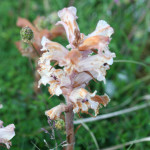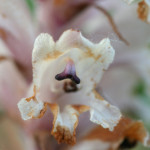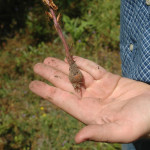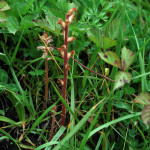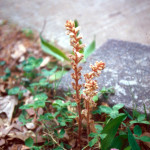Gallery:
- Orobanche minor flowers
- Orobanche minor flower
- Orobanche minor root
- Orobanche minor flowers
- Orobanche minor stem and habitat
- Orobanche minor flowers
Common names:
Small broomrape, hellroot
Scientific Name:
Orobanche minor
Description:
Annual; blooms within a week of plant emergence. Like other parasitic plants, small broomrape lacks chlorophyll. The flower stalk is yellowish-brown, unbranched with a purplish tint. Leaves look like small triangular scales. Flowers pinkish, yellow or white in color and arranged in an elongated spike.
Life cycle:
Height of mature plants
6 to 12 inches
Flower color:
Pink, Yellow, White
Bloom time:
December through April
Look-a-likes:
Habitat:
This species primarily impacts areas under cultivation of clover in our area, but is also associated with disturbed areas, other crops, roadsides and waste places on a wide range of soil types.
Impacts:
Upon germination, the first root attaches to and penetrates the root of the host plant, usually clover and other legumes, disrupting nutrients and water transport in the host root system. It has the ability to produce up to 500,000 seeds per plant that are dispersed by wind, tillage equipment, harvesters, commodity movement and animals. An uprooted flowering plant will continue to produce seed. Heavy infestations can cause severe crop damage that may result in nearly total crop failure. It is especially problematic in clover crops where the Orbanche seeds are hard to detect or remove during mechanical cleaning of harvested seed.
Noxious Weed Listing:
- WeedWise: Maintenance
- State of Oregon: Class B
- State of Washington: Not listed
- Four County CWMA: Class D
- Columbia Gorge CWMA: Class A
Origin:
Europe, North Africa and western Asia
Links:
Oregon Noxious Weed Profile
Invasive.org profile
CABI Invasive Species Compendium
BugwoodWiki

